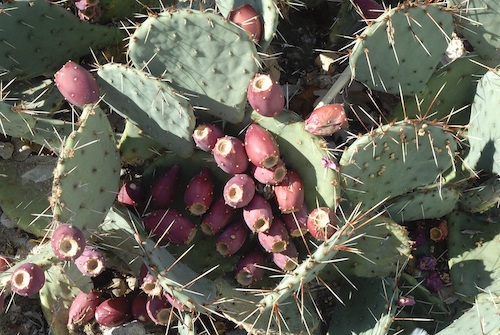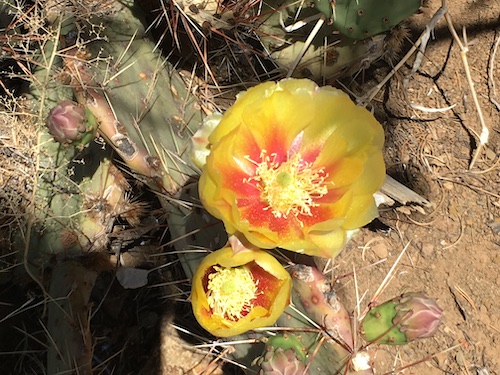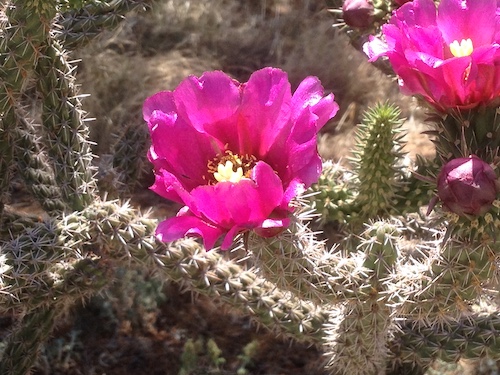The Chronicles Of Grant County
Cactus
 A Prickly Pear Cactus and its fruits, called tunas, in New Mexico in 2008. (The photograph was produced by Alice Welch and provided courtesy of the USDA.)
A Prickly Pear Cactus and its fruits, called tunas, in New Mexico in 2008. (The photograph was produced by Alice Welch and provided courtesy of the USDA.)
 Prickly Pear in bloom. Photo by Mary Alice Murphy
Prickly Pear in bloom. Photo by Mary Alice Murphy
The Cactus is the source of the names for four roadways in Grant County, including three Cactus Streets – one each in Bayard, Santa Clara, and Silver City as well as Mimbres Cactus Drive in Mimbres.
For a number of years, the Cactus was considered by many to be the state flower of New Mexico.
The designation of the Cactus as the state flower was almost made official a few times, but it appears that many of the leaders of New Mexico did not want the Cactus to receive that recognition.
Efforts to adopt a state flower of New Mexico began even before the state became a state.
Several newspapers in the early 20th century indicated that the Cactus was already the state flower of New Mexico.
The New York Times – yes, The New York Times – reported that the Cactus was the state flower of New Mexico in a news article dated January 28, 1900. (New Mexico did not become a state until 1912.) The newspaper detailed a number of state flowers and explained that the selection of the state flowers was “by vote of school children, popular vote, or legislation.”
A likely more accurate explanation of the situation in New Mexico was printed in The Tacoma Times in Washington State in a news article dated January 30, 1913: “The state flower of New Mexico is the Cactus. It was not adopted but generally accepted.”
On March 20, 1914, the Santa Fe New Mexican reported that “a Cactus is already placed on ‘a state flower map’ now hanging in the office of the department of public instruction [in Santa Fe].” According to the newspaper, the “map was not published here.”
On the next day, this newspaper reported that “The Cactus and the Yucca have both been suggested as the official New Mexico state flower.” Other flowers were also considered by leaders in the state.
In New Mexico, there was one vote confirmed among public school children and likely two other votes by public school children.
On March 31, 1914, the Albuquerque Journal reported on the tentative results of a vote conducted by the Superintendent of Industrial Education: “Almost 3,500 votes have been counted” thus far in the state flower contest. The news article noted that the Primrose was on top with 808 votes, with the Sweet Pea garnering 607 votes and Cosmos receiving 531 votes.
This newspaper article indicated that the Yucca was coming in 4th place and the Cactus in 5th place among voters.
The tide appeared to turn more in favor of the Cactus as additional votes were counted. The Santa Fe New Mexican reported that, as of April 3, 1914, there were 905 votes for the Primrose, 885 votes for the Cactus, and 821 votes for the Sweet Pea. This newspaper explained that the votes were coming from school children throughout the state.
Three days later, the newspaper reported that the Cactus was now the clear leader to become the state flower based on the voting by public school children. “The Cactus, prickly and treacherous, has snatched first place in the state flower election, and now has 1,121 votes of school children,” reported the Santa Fe New Mexican on April 6, 1914. The Wild Rose had the second most votes, the Sweet Pea was in third place, and the Primrose had fallen to fourth place.
A few weeks later, once all the votes of the public school children were tabulated, New Mexico announced the winner.
“Cactus Triumphant!” was a small headline on page three of the edition of the Albuquerque Journal dated June 4, 1914. This news article noted that this was the third election in which the Cactus won to be the state flower. (Specific details on the two previous elections by the New Mexico Department of Education have thus far been elusive.)
On August 14, 1914, the Santa Fe New Mexican reported the final results of the voting: Children in twenty-one of the twenty-six counties then in New Mexico voted on 79 different flowers. (Note: The state now includes 33 counties.) This newspaper reported that there was a total of 13,997 votes with the flowers with the most votes being won by the “Cactus, 3239; Wild Rose, 1834; Sweet Pea, 1831; Yucca, 1507; Cosmos, 1194; Primrose, 1008; Mariposa Lily, 817; Alfalfa, 432; Mountain Violet, 384; Daisy, 228; Verbena, 199; Sunflower, 193; and Carnation, 110.”
The results of the voting by public school children notwithstanding, newspaper reports of the time explained that leaders in New Mexico did not want an image of the state as a desert environment. The view was that having the Cactus as a state symbol would reinforce what leaders considered to be negative images of New Mexico.
The El Paso Morning Times reported on August 16, 1914, that “Leading educators are assailing the Cactus in the public prints.”
Mr. Antonio Lucero, then the Secretary of State in New Mexico, was quoted in the edition of the Santa Fe New Mexican dated August 14, 1914, as stating that “I do not think it a matter that should be left wholly to the school children.” He also noted that “…the Cactus suggests a desert country and New Mexico wishes to combat the idea that it is an arid region.”
On August 27, 1914, the Santa Fe New Mexican indicated that “The State Board of Education will probably leave the selection of a state flower to the Legislature.”
It took 13 more years, but the issue was finally settled when the New Mexico State Legislature designated an official State Flower on March 14, 1927.
It was not to be the Cactus. Instead, state leaders chose the Yucca to be the official state flower of the 47th state.
During those intervening years, it appears that while no official designation was made, the Cactus was considered the state flower of New Mexico anyway.
The Cactus was listed as the state flower of New Mexico in an edition of the Harrisburg Star-Independent in Pennsylvania on March 27, 1915; The Vancouver Daily Sun of British Columbia reported that the Cactus was the state flower of New Mexico in its issue dated July 28, 1917; and in New York State, The Buffalo Evening Times stated on November 22, 1919, that the state flower of New Mexico was the Cactus.
The Beaver Press of Beaver City in Utah noted in a news article dated August 5, 1921, that the Cactus was the state flower in both Arizona and New Mexico.
Two years later, The Billings Gazette in Montana reported that the Cactus was the state flower of New Mexico. This newspaper also reported that the state motto was “It Increases By Going.” Today, the New Mexico Secretary of State indicated that the state motto – still written in the same Latin text as in 1923 – is “It Grows As It Goes.”
Despite the vote by the state legislature in 1927, the Cactus continued to be recognized on occasion as the state flower by others outside of New Mexico.
The Indianapolis Sunday Star published a news article on February 2, 1941, that the state flower of New Mexico was the Cactus, and The Philadelphia Inquirer reported on May 28, 1944, that the Cactus was the state flower of the 47th state.
While only New Mexico has designated the Yucca as its state flower, there was an effort in the 19th century for another state to name the Yucca as its state flower.
According to a news article dated July 8, 1897, in the Lane County Journal of Dighton, Kansas, “The Hugoton Hermes suggests that in providing a state flower for Kansas the Yucca, commonly known as the soapweed, should have consideration.”
Six years later, the State of Kansas designated the Sunflower as its state flower instead of the Yucca.
Today, Arizona is the only state to recognize the Cactus as a state symbol.
 Cholla - another common cactus in southwestern New Mexico. Photo by Mary Alice Murphy
Cholla - another common cactus in southwestern New Mexico. Photo by Mary Alice Murphy
Do you have questions about communities in Grant County?
A street name? A building?
Your questions may be used in a future news column.
Contact Richard McDonough at chroniclesofgrantcounty@gmail.com.
© 2019 Richard McDonough


